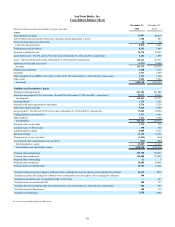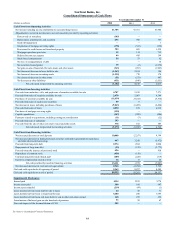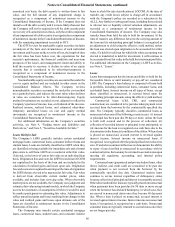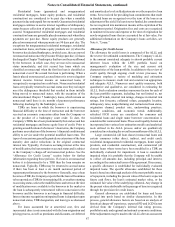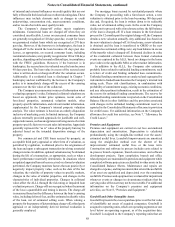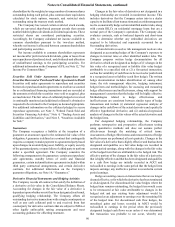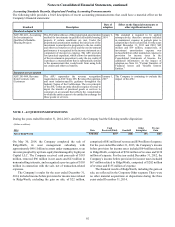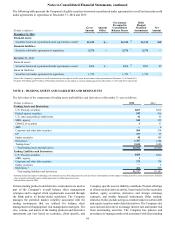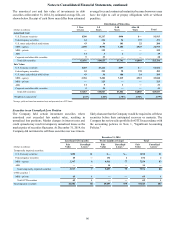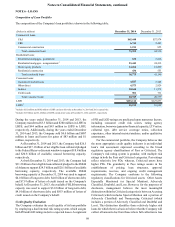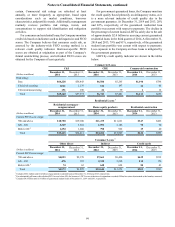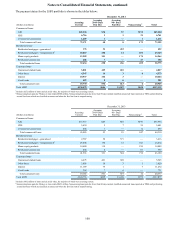SunTrust 2014 Annual Report Download - page 113
Download and view the complete annual report
Please find page 113 of the 2014 SunTrust annual report below. You can navigate through the pages in the report by either clicking on the pages listed below, or by using the keyword search tool below to find specific information within the annual report.Notes to Consolidated Financial Statements, continued
90
shareholders by the weighted average number of common shares
outstanding during each period, plus common share equivalents
calculated for stock options, warrants, and restricted stock
outstanding using the treasury stock method.
The Company has issued certain restricted stock awards,
which are unvested share-based payment awards that contain
nonforfeitable rights to dividends or dividend equivalents. These
restricted shares are considered participating securities.
Accordingly, the Company calculated net income available to
common shareholders pursuant to the two-class method,
whereby net income is allocated between common shareholders
and participating securities.
Net income available to common shareholders represents
net income after preferred stock dividends, gains or losses from
any repurchases of preferred stock, and dividends and allocation
of undistributed earnings to the participating securities. For
additional information on the Company’s EPS, see Note 12, “Net
Income Per Common Share.”
Securities Sold Under Agreements to Repurchase and
Securities Borrowed or Purchased Under Agreements to Resell
Securities sold under agreements to repurchase and securities
borrowed or purchased under agreements to resell are accounted
for as collateralized financing transactions and are recorded at
the amounts at which the securities were sold or acquired, plus
accrued interest. The fair value of collateral pledged or received
is continually monitored and additional collateral is obtained or
requested to be returned to the Company as deemed appropriate.
For additional information on the collateral pledged to secure
repurchase agreements, see Note 3, "Federal Funds Sold and
Securities Financing Activities," Note 4, "Trading Assets and
Liabilities and Derivatives," and Note 5, "Securities Available
for Sale."
Guarantees
The Company recognizes a liability at the inception of a
guarantee at an amount equal to the estimated fair value of the
obligation. A guarantee is defined as a contract that contingently
requires a company to make payment to a guaranteed party based
upon changes in an underlying asset, liability, or equity security
of the guaranteed party, or upon failure of a third party to perform
under a specified agreement. The Company considers the
following arrangements to be guarantees: certain asset purchase/
sale agreements, standby letters of credit and financial
guarantees, certain indemnification agreements included within
third party contractual arrangements, and certain derivative
contracts. For additional information on the Company’s
guarantor obligations, see Note 16, “Guarantees.”
Derivative Financial Instruments and Hedging Activities
The Company records all contracts that satisfy the definition of
a derivative at fair value in the Consolidated Balance Sheets.
Accounting for changes in the fair value of a derivative is
dependent upon whether or not it has been designated in a formal,
qualifying hedging relationship. The Company offsets all
outstanding derivative transactions with a single counterparty as
well as any cash collateral paid to and received from that
counterparty for derivative contracts that are subject to ISDA or
other legally enforceable netting arrangements and meet
accounting guidance for offsetting treatment.
Changes in the fair value of derivatives not designated in a
hedging relationship are recorded in noninterest income. This
includes derivatives that the Company enters into in a dealer
capacity to facilitate client transactions and as a risk management
tool to economically hedge certain identified market risks, along
with certain IRLCs on residential mortgage loans that are a
normal part of the Company’s operations. The Company also
evaluates contracts, such as brokered deposits and short-term
debt, to determine whether any embedded derivatives are
required to be bifurcated and separately accounted for as
freestanding derivatives.
Certain derivatives used as risk management tools are also
designated as accounting hedges of the Company’s exposure to
changes in interest rates or other identified market risks. The
Company prepares written hedge documentation for all
derivatives which are designated as hedges of (1) changes in the
fair value of a recognized asset or liability (fair value hedge)
attributable to a specified risk or (2) a forecasted transaction,
such as the variability of cash flows to be received or paid related
to a recognized asset or liability (cash flow hedge). The written
hedge documentation includes identification of, among other
items, the risk management objective, hedging instrument,
hedged item and methodologies for assessing and measuring
hedge effectiveness and ineffectiveness, along with support for
management’s assertion that the hedge will be highly effective.
Methodologies related to hedge effectiveness and
ineffectiveness are consistent between similar types of hedge
transactions and include (i) statistical regression analysis of
changes in the cash flows of the actual derivative and a perfectly
effective hypothetical derivative, and (ii) statistical regression
analysis of changes in the fair values of the actual derivative and
the hedged item.
For designated hedging relationships, the Company
performs retrospective and prospective effectiveness testing
using quantitative methods and does not assume perfect
effectiveness through the matching of critical terms.
Assessments of hedge effectiveness and measurements of hedge
ineffectiveness are performed at least quarterly. Changes in the
fair value of a derivative that is highly effective and that has been
designated and qualifies as a fair value hedge are recorded in
current period earnings, along with the changes in the fair value
of the hedged item that are attributable to the hedged risk. The
effective portion of the changes in the fair value of a derivative
that is highly effective and that has been designated and qualifies
as a cash flow hedge are initially recorded in AOCI and
reclassified to earnings in the same period that the hedged item
impacts earnings; any ineffective portion is recorded in current
period earnings.
Hedge accounting ceases on transactions that are no longer
deemed effective, or for which the derivative has been terminated
or de-designated. For discontinued fair value hedges where the
hedged item remains outstanding, the hedged item would cease
to be remeasured at fair value attributable to changes in the
hedged risk and any existing basis adjustment would be
recognized as an adjustment to earnings over the remaining life
of the hedged item. For discontinued cash flow hedges, the
unrealized gains and losses recorded in AOCI would be
reclassified to earnings in the period when the previously
designated hedged cash flows occur unless it was determined
that transaction was probable to not occur, whereby any




